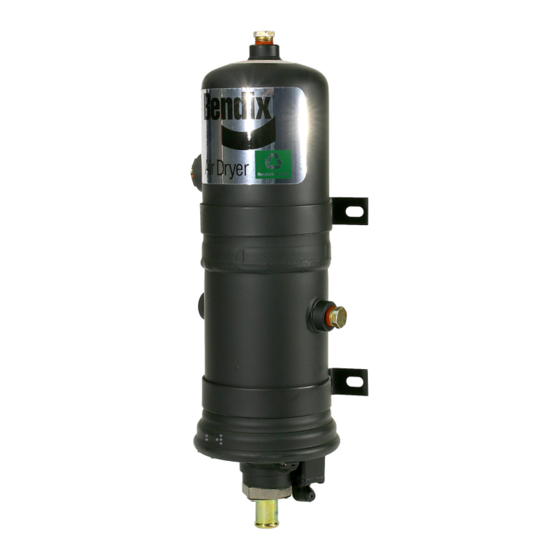BENDIX AD-1 Service Data - Page 3
Parcourez en ligne ou téléchargez le pdf Service Data pour {nom_de_la_catégorie} BENDIX AD-1. BENDIX AD-1 16 pages.
Également pour BENDIX AD-1 : Manuel (16 pages)

GENERAL SAFETY GUIDELINES
WARNING! PLEASE READ AND
FOLLOW THESE INSTRUCTIONS
TO AVOID PERSONAL INJURY OR DEATH:
When working on or around a vehicle, the following
guidelines should be observed AT ALL TIMES:
▲Park the vehicle on a level surface, apply the parking
brakes and always block the wheels. Always wear personal
protection equipment.
▲Stop the engine and remove the ignition key when working
under or around the vehicle. When working in the engine
compartment, the engine should be shut off and the ignition
key should be removed. Where circumstances require that
the engine be in operation, EXTREME CAUTION should be
used to prevent personal injury resulting from contact with
moving, rotating, leaking, heated or electrically-charged
components.
▲Do not attempt to install, remove, disassemble or
assemble a component until you have read, and thoroughly
understand, the recommended procedures. Use only the
proper tools and observe all precautions pertaining to use
of those tools.
▲If the work is being performed on the vehicle's air brake
system, or any auxiliary pressurized air systems, make
certain to drain the air pressure from all reservoirs before
beginning ANY work on the vehicle. If the vehicle is
equipped with a Bendix
®
DRM
™
dryer reservoir module, or a Bendix
dryer, be sure to drain the purge reservoir.
▲ Following the vehicle manufacturer's recommended
procedures, deactivate the electrical system in a manner
that safely removes all electrical power from the vehicle.
▲Never exceed manufacturer's recommended pressures.
▲Never connect or disconnect a hose or line containing
pressure; it may whip and/or cause hazardous airborne
dust and dirt particles. Wear eye protection. Slowly open
connections with care, and verify that no pressure is
present. Never remove a component or plug unless you are
certain all system pressure has been depleted.
▲ Use only genuine Bendix
components and kits. Replacement hardware, tubing, hose,
fi ttings, wiring, etc. must be of equivalent size, type and
strength as original equipment and be designed specifi cally
for such applications and systems.
▲Components with stripped threads or damaged parts should
be replaced rather than repaired. Do not attempt repairs
requiring machining or welding unless specifi cally stated
and approved by the vehicle and component manufacturer.
▲Prior to returning the vehicle to service, make certain all
components and systems are restored to their proper
operating condition.
▲ For vehicles with Automatic Traction Control (ATC), the ATC
function must be disabled (ATC indicator lamp should be
ON) prior to performing any vehicle maintenance where
one or more wheels on a drive axle are lifted off the ground
and moving.
▲The power MUST be temporarily disconnected from the
radar sensor whenever any tests USING A DYNAMOMETER
are conducted on a vehicle equipped with a Bendix
Wingman
®
system.
▲You should consult the vehicle manufacturer's operating
and service manuals, and any related literature, in
conjunction with the Guidelines above.
AD-IS
®
air dryer system, a Bendix
®
AD-9si
®
brand replacement parts,
The end cover assembly is retained by a lock ring, as well
as cap screws and retainers, and houses the purge valve
and heater assembly if so equipped.
The heater and thermostat assembly prevent freeze-up
in the purge drain valve when the dryer is used in severe
winter conditions. The heater and thermostat assembly is
standard in the Bendix
equipment for the Bendix
watt and 24 volt / 60 or 120 watt DC heater and thermostat
assembly has an operating range between 45°F and 85°F.
NOTE: The heater and thermostat assembly provided with
the AD-2 air dryer has a 3/16" diameter threaded electrical
terminal protected by a boot. The AD-1 air dryer assembly
incorporates a #16 gauge lead wire. Both types are
serviceable. The heater and thermostat assembly should
be connected to the "on" position of the engine control or
ignition switch and protected with the proper size fuse.
For details on installation, please refer to the "Installation"
section.
OPERATION
The operation of the air dryer can best be described by
separating the operation into two cycles; the charge cycle
®
and the purge cycle.
®
air
Charge Cycle: (See Figure 3.) A compressor in the
compressing cycle - With the compressor in its "loaded"
or compressing cycle, air from the compressor enters the
air dryer through the discharge line. When the air – along
with the water and contaminants – enters the air dryer, the
velocity or speed of the air reduces substantially and much
of the entrained liquid drops to the bottom (or sump) of
the air dryer. The initial air fl ow is toward the bottom of the
dryer, but air fl ow direction changes 180° at the bottom of
the air dryer, dropping some water and oil.
The air now passes through the oil separator fi lter which
removes oil and foreign material but does not remove water
vapor. At this point, the air remains saturated with water.
The fi ltered air and vapors penetrate the desiccant drying
bed and the adsorption process begins. Water vapor is
removed from the air by the desiccant.
The unsaturated "dry" air passes through the ball check
valve and purge orifi ce into the purge volume. From the
purge volume air fl ows through an outlet check valve, and
into the fi rst reservoir.
NOTE: The AD-1 air dryer does not incorporate an integral
outlet check valve. The single check valve in an AD-1 air
dryer installation would be located in the line between the
®
AD-1 air dryer outlet port and the fi rst reservoir.
®
AD-2
®
air dryer and was optional
®
™
AD-1
air dryer. The 12 volt / 60
3
